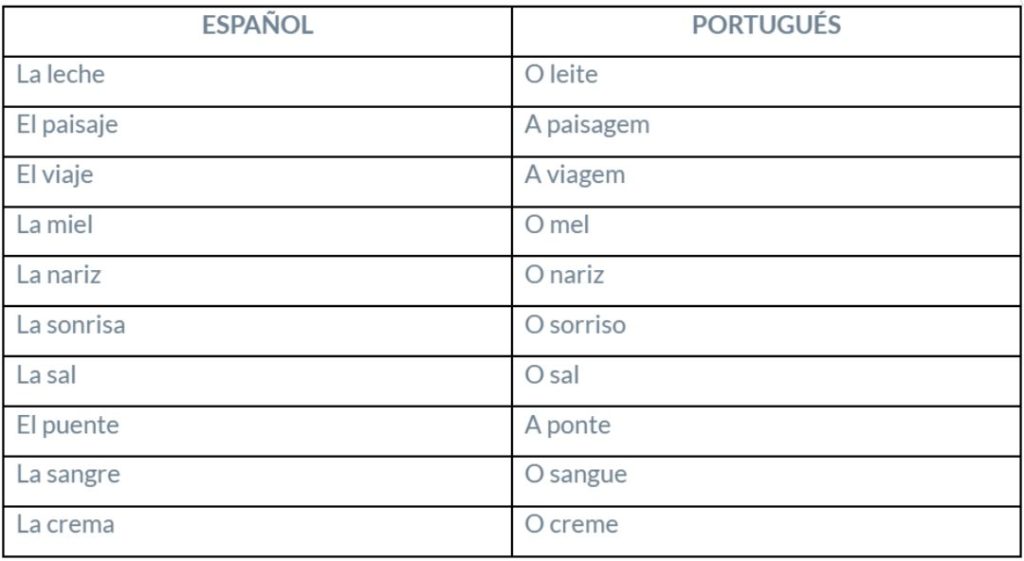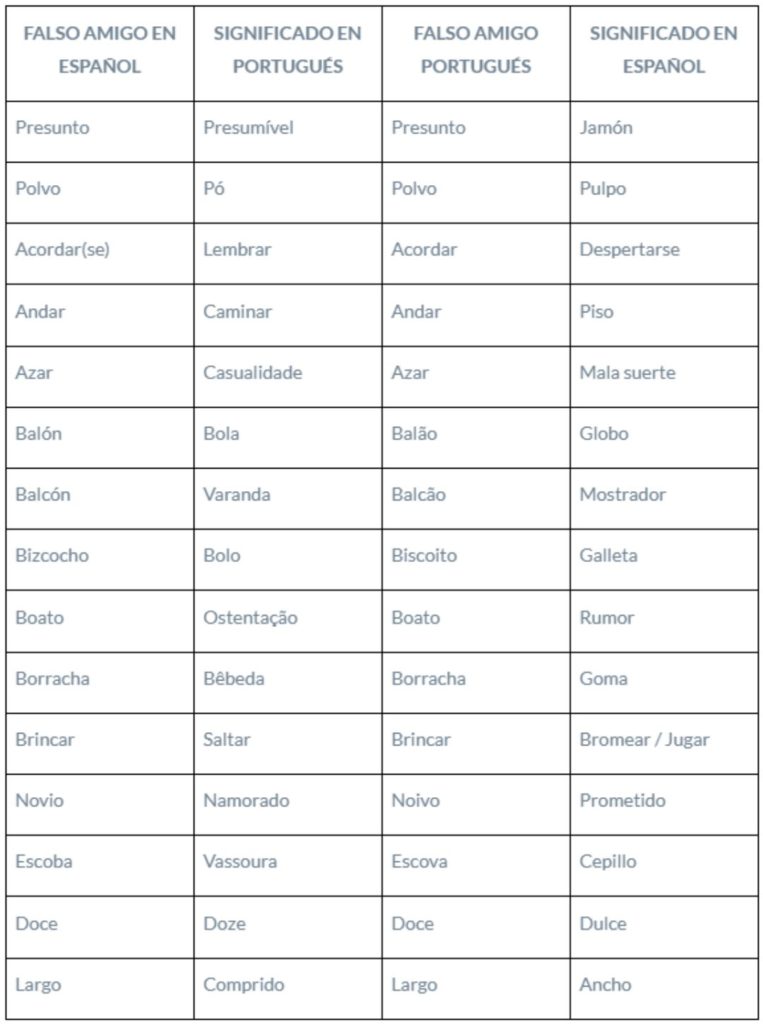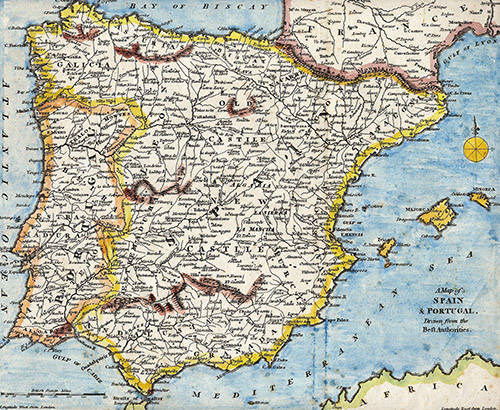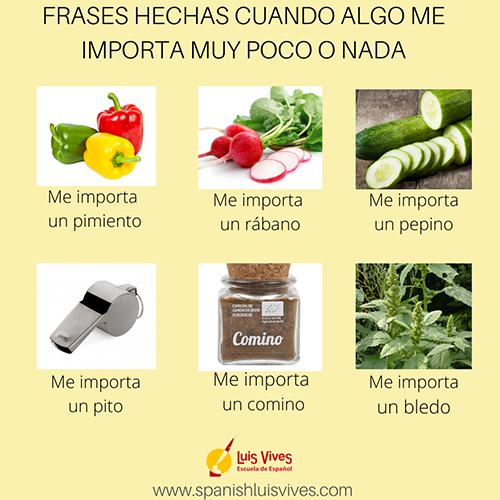Hello, Live! If you want to learn Spanish and your native language is Portuguese, this article interests you. For 25 years we have received numerous students in our School whose mother tongue is Portuguese and who come from the different countries in which this wonderful language is spoken: Portugal, Brazil, Angola, Mozambique or East Timor. As Center Accredited by the Cervantes Institute for the Teaching of Spanish as a Foreign Language, our School has teachers with great experience and the ability to detail the most important differences and similarities between Spanish and Portuguese, and give you some tricks and tips so that you can get the most out of your Spanish classes, whether online or in person. Let's go!
Recommendation: DO NOT translate this page into your language, stay in the Spanish version to better understand the article.

DIFFERENCES between Spanish and Portuguese
If there is a problem for Lusophone students, it is the closeness and similarity between Spanish and Portuguese. The lexical similarity between both languages is more than 85% and their grammatical structure is similar. For this reason, sometimes the greatest difficulty is distinguishing what things are the same and what are different in each of the languages. It is not strange to often see Portuguese-speaking students who feel insecure when speaking Spanish, since in many cases they doubt whether what they are saying is Spanish or whether they are making a direct translation from their own language. That is, they don't know if they are speaking Spanish or they are resorting to that terrifying intermediate system called “portuñol”. Well, to avoid making these types of errors, it is best to be very clear about the differences between both systems. We are going to detail them for you point by point.
The ubiquitous LO article
If there is one thing that characterizes the true speaker of “portuñol”, it is the indiscriminate use of the form “lo”. This error lies in the fact that in Portuguese the masculine definite article is “o” (for example “o chão” = “the ground”), while in Spanish the corresponding form is “the”. Many students tend to always use the form “lo” instead of the masculine article and thus say things like *I ground it🇧🇷the dog🇧🇷the boy, which are not correct in Spanish.
However, many of you will be thinking: but have I heard Spaniards using the form “lo” as an article? Well yes, you are right. But this “it” is neutral and never accompanies nouns, but appears with adjectives when we are not referring to a specific thing and speak generically. So, we can say things like “The best thing about the movie is the ending" or "The important thing is to try” when the adjective does not refer to a specific male or female noun. So now you know, the important thing is that you never use the article “lo” together with a noun.
The verb to like
Another common obstacle is the difference in the structure of the verb GUSTAR in Spanish and Portuguese. Thus, it is normal to hear phrases like *“I really like Italian food”, which are not correct in Spanish. In Portuguese, the verb gustar has a preposition and the subject is the person who experiences the action. Thus, the previous phrase would be “Eu gosto muito da food Italiana”. However, both the verb gustar and many other feeling verbs have a different structure in Spanish, since the person experiencing the action corresponds to the indirect object, while the subject appears last. That is, the previous sentence in Spanish would be: “I really like Italian food”, where the person (A mí / me) is the indirect object and the Italian food is the subject.
YOU and YOU are not the same
Another common confusion between Spanish and Portuguese is found in the use of pronouns. In Spanish the forms “Tú” and “Vosotros” correspond to familiar use and are accompanied by a specific verbal form. So, we say things like “Do you want more soup?” o “Do you want anything else?” when the relationship with our interlocutors is close. For formal use, we use the pronouns “You” and “You” with their respective verbal forms. Thus, the formal variants of the previous phrases would be “Do you want more soup?” o “Do you want anything else?”, when we want to speak more formally. (It must be said that these uses correspond to the variant of standard Spanish associated with Spanish from the north of the peninsula and that in the south and in Latin America its use is different).
In Portuguese the plural form “Vocês” serves both formal and informal contexts and appears with a third person verb. Therefore, it is normal for many students to translate it as “You” and add a verb in the third person. However, examples like *“You Spaniards are very kind” are not correct, since they combine the familiar pronoun “you” with the third person plural verb “are.” So, pay close attention! Or we say “You are very kind” o "You're very kind".
Gender differences
Although most of the words between Spanish and Portuguese coincide in gender, there is a list of keywords that do not share it, and it can be very useful for you to know them to avoid errors in their use. Here you can see some of the most important ones:

Where do I put the pronouns?
Another problem that drives students who want to learn Spanish when their native language is Portuguese crazy is the position of object pronouns, since in Portuguese the placement rules are different. Therefore, it is not strange to hear incorrect phrases such as *”I come to tell you something” o *“I want to visit you next year”, which copy the structure directly from Portuguese. In these cases, the correct thing would be to say: “I come to tell you something” o “I want to visit you next year”. So, if you want to place the pronouns correctly in Spanish, do not translate and remember that in Spanish the pronouns always come before the conjugated verb and only come after in these three cases:
- After the verb in the infinitive: "I want to givele the gift tomorrow.”
- After the verb in gerund: "We are learninglo little by little".
- After the verb in the affirmative imperative: “Dame the hand".
"ALSO NOT"
In both Portuguese and Spanish there is the form “também” and “also” respectively to express agreement in an affirmative way. However, while in Portuguese we say “também não” to express agreement in a negative way, in Spanish we say “tampoco”. So you know, never say *“I don't like it too" if not "I do not like it either".
THE “PESSOAL INFINITIVE” does not exist in Spanish
Although the verbal system is almost identical in both Portuguese and Spanish and the use of tenses is not usually a problem for Portuguese-speaking students, there is one structure in Portuguese for which there is no correspondence in Spanish. The problem in these cases is that many students translate directly and create phrases that do not exist in Spanish. For example, from the Portuguese phrase “Even though we have a lot of money, we are ignorant” some students translate *“Despite having a lot of money, they are ignorant”. But no, the form “teneren” does not exist in Spanish, because in our verbal system there is no personal infinitive, so the correct thing would be to say “Despite having a lot of money, they are ignorant”.
Fake friends
Well yes, as we said at the beginning, Spanish and Portuguese share more than 80% of their lexical base, but we can also find some surprises. So if in most cases, from a Spanish word we can know its corresponding word in Portuguese and vice versa, it is not always so easy and, in many cases, although the word exists in an almost identical way, its meaning is not the same. same. They are as famous as feared “false friends”, and the list is endless. Below you can see a list with some of the most important examples.

Problems with PHONETICS
Portuguese has a greater number of phonemes than Spanish, which makes it a little more complicated for Spaniards to both understand it and pronounce it correctly. However, there are some sounds in Spanish that can also be difficult for Portuguese speakers.
The Z and C of BEER
One of the sounds that is most difficult for those who want to learn Spanish when Portuguese is their native language is the pronunciation of the voiceless dental fricative or interdental sound. This sound is typical of the accent of the Iberian Peninsula, although in some regions of Andalusia and the Canary Islands, it has practically disappeared. In Latin American Spanish it does not exist either. This sound is represented by the letter z, and by the letter c when followed by eo i. In the International Phonetic Alphabet it is represented with this symbol: /θ/. Some words that have this sound in peninsular Spanish are: cereals, pray, conscience, hunter, ignite.
Council: To pronounce this sound you must place the tip of your tongue between your teeth and blow lightly.
The double R of ROME
Another sound that is difficult for our Portuguese-speaking students to pronounce is that of the alveolar vibrating voice, graphically represented by a double ro or strong r at the beginning of a word or after a consonant, represented by the International Phonetic Alphabet in this way: /r̄ /. Some words that have this sound in peninsular Spanish are: remember, run, around, coil, fox, mud.
Although this sound also exists in many Portuguese-speaking areas, in many other places the double r is guttural, that is, the point of articulation is in the throat, as in the case of the French r. In these cases you have to pay close attention, since many students can confuse the pronunciation of verbs such as correr y by.
Council: To pronounce this sound, place the tip of your tongue on the roof of your mouth (in the part closest to the front teeth) and make it vibrate.
Confusions with the Ñ
The palatal nasal sound represented graphically with the letter ñ also exists in Portuguese and is represented by the double spelling “nh” in Portuguese. Although many words that have -nh- in Portuguese also have -ñ- in Spanish (strange/strange; amanhã/morning), it does not coincide in all cases: path/path; money/money; nephew/nephew; win/win; etc.). So now you know, don't trust yourself and first think if the word has -ñ- in Spanish or not.
Be careful with SPELLING
In Portuguese there are some double spellings that also exist in Spanish, such as the double rr, as we have already told you about. However, there is one that does not exist in Spanish and that is one of the most frequent errors in Portuguese-speaking students when they write: it is the case of the double that -ss-. Thus, it is important to remember that words that are written with double that -ss- in Portuguese will always have a single that -s- in Spanish, since there is no option for double that -ss- in our language. This is the case of words like: pass/pass; session/session; past/past; process/process).
Another problem is that of -b- and -v-. Although Spanish and Portuguese normally coincide, this is not always the case. The most important cases that you always have to remember are the verb “duty” (duty in Portuguese), “have” (oats in Portuguese) and all the verbs of the first conjugation in the imperfect tense: was, walked, arrived, etc., which in Portuguese are with -v-.
Tips for learning Spanish if your native language is Portuguese
If you want to learn Spanish and your native language is Portuguese, there are many options to perfect your level of Spanish. In general, we always recommend that students do the things they like, but in Spanish. It is the best way not to get bored and learn while having fun. Anyway, if you need some inspiration, here we give you some tips and alternatives to improve your Spanish in different ways. Below you will find links to other very useful websites. These are not sponsored links. Remember that Luis Vives does not use covert promotion techniques. In fact, we are against these practices.
Leather
Reading is one of the best ways to learn a language and acquire new vocabulary. Sometimes, certain graded readings can be uninteresting. What we recommend you do if you like reading is that you read the same type of books that you already read in your language. Although there are many options, if you don't have a library or a good second-hand bookstore nearby with books in Spanish, you can always access virtual libraries: we suggest this.
Talk
Of course, this is the best way to learn Spanish if your native language is Portuguese. Furthermore, we Spaniards are very talkative, so it is best that you start training your oral expression as soon as possible. If you live in a Spanish-speaking country, you can surely find a cafe or place where linguistic exchanges take place periodically. But if not, no problem, on the internet you can also find people willing to do language exchanges and thus improve your oral expression. For example in this website You can register and find people with whom you can practice more informally.
However, if you are shy or do not have time, a very useful thing can be to record yourself with your own cell phone answering some questions and then listen to yourself to see what you can improve or, if you like series or movies, you can try to remember small dialogues of Spanish series and then repeat them. Yes, it seems a little crazy, but it works.
Listen to a podcast
It's true, podcasts are more fashionable than ever and you've surely heard many in your language. In this case, we also recommend that you listen to podcasts on topics that interest you, since this way you will not get bored and you will turn your learning into a pleasure. If you are looking for a variety of topics, you can listen to the podcasts offered by Spanish public television on its websites. But, above all, you cannot miss the podcasts that we make at our school, since they are specially designed so that our students can improve their Spanish in an entertaining way. You can take a look at an interview we did with a Brazilian student here.
Take a Spanish course
Of course. Taking a Spanish course is always one of the best ways to learn and improve. Contact with a native teacher who resolves those doubts for which you sometimes do not have answers is very important, just as being able to be in contact with other students who have a similar level to yours can help you lose your fear of speaking Spanish. And what is the best option if you are in Madrid or want to come visit the city? Of course, the best option is our Madrid School.
Expand your radius of action
If you live in a country where Spanish is spoken, don't limit yourself to just taking a language course. If you have a passion, join a group with Spaniards to practice. The options are endless: a theater group, a cooking school, a hiking group, a musical band. The topic doesn't matter! The important thing is that you like it and that you can learn Spanish.
Watch movies or series
Of course, cinema is one of our great allies when it comes to learning a language. By watching movies or series you can improve your vocabulary and learn a lot of colloquial expressions. A good option due to its extensive catalog is the website of RTVE. But if you are an inveterate film lover, you cannot miss the range of films offered by the Spanish platform. The film.
Listen to music
Who does not like music? Now, listening to music is easier than ever thanks to platforms like YouTube or Spotify. Don't you know much music in Spanish? Well don't worry, we offer you a lot of songs for all tastes in she is ready made by the teachers of our school.
Teaching Spanish to Portuguese Speakers
Being a Spanish teacher in Portugal was for me one of the most enriching professional experiences of my life. In Portugal I had the opportunity to teach Spanish to students of different profiles, from universities or language schools to vocational training courses funded by the Porto City Council, the city where I spent almost five years. From all my students I was able to learn unforgettable things, both about the country's culture and its language.
However, upon returning to Madrid my Portuguese-speaking horizon expanded, since at our school I have been lucky enough to meet students from other Portuguese-speaking countries: Brazil, Angola or East Timor. Like Portuguese, Spanish is an immense language with great variations, an aspect that undoubtedly enriches it and makes it even more interesting. Therefore, in these tips we have tried to focus on the most important interferences between Spanish and Portuguese, which can be a useful guide for students from any Portuguese-speaking country. However, between different Spanish-speaking countries there are differences in pronunciation, in the uses of certain parts of grammar and, above all, in vocabulary. And the same goes for Portuguese.
But, whatever variant of Portuguese you speak or Spanish you want to learn, these tips can be very useful. And, above all, don't forget: never be afraid of making mistakes and enjoy the experience of learning Spanish. Well, if you want to learn Spanish and your native language is Portuguese, I hope this article helps you in your learning. My name is Daniel Agudo, and I am a Spanish teacher at Luis Vives Escuela de Español. See you soon!










 the greek word Spain It is recorded for the first time in the XNUMXst century BC. C. The geographer Artemidorus of Ephesus used it as a variant of the Greek Hispania, which passed into Latin as Hispania. At that same time that name was used by Julius Caesar, who distinguished the Hispanic later, beyond the Ebro River, and the Citerior Hispania, south of the Ebro River. After the union of the kingdoms of Castile and Aragon with the wedding of the Catholic Monarchs, the name of Hispania It began to be used heavily for the country.
the greek word Spain It is recorded for the first time in the XNUMXst century BC. C. The geographer Artemidorus of Ephesus used it as a variant of the Greek Hispania, which passed into Latin as Hispania. At that same time that name was used by Julius Caesar, who distinguished the Hispanic later, beyond the Ebro River, and the Citerior Hispania, south of the Ebro River. After the union of the kingdoms of Castile and Aragon with the wedding of the Catholic Monarchs, the name of Hispania It began to be used heavily for the country.


 In Chaldea (a region of Mesopotamia), the inhabitants offered beer to the gods as tribute.
In Chaldea (a region of Mesopotamia), the inhabitants offered beer to the gods as tribute.

 Christmas tree
Christmas tree



